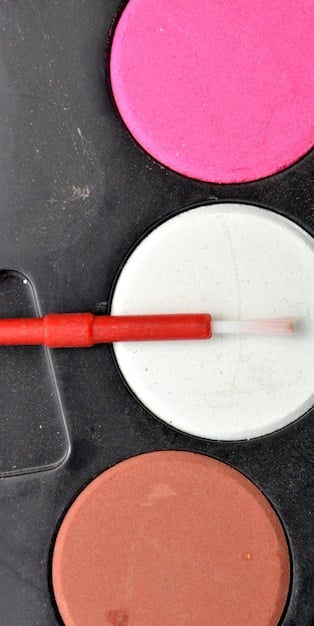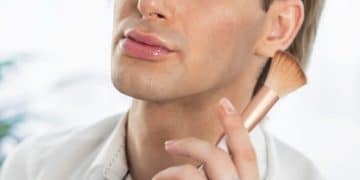How to Choose the Right Makeup Brushes: A 2025 Guide for Men

Choosing the right makeup brushes is essential for achieving a flawless and natural look. This 2025 guide provides a comprehensive overview of different brush types, materials, and techniques to help men select the best makeup brushes for their specific needs and preferences.
Achieving a flawless makeup look requires more than just quality products; it demands the right tools. For men venturing into makeup or looking to refine their routine, understanding how to choose the right makeup brushes for your needs: a 2025 guide is crucial. Let’s dive into the world of brushes tailored for the modern man.
Why the Right Makeup Brushes Matter for Men
Many guys starting with makeup don’t realize how important the tools are. Using your fingers or the applicators that come with some products simply doesn’t deliver the same results as using the correct brush. The right brushes ensures even application, blend seamlessly and lets you control the intensity, and will give you a professional look.
Precision and Control
Makeup brushes are designed for precision. They allow you to target specific areas of your face with accuracy, whether you’re concealing blemishes, contouring your cheekbones, or applying eyeshadow. This level of control is essential for achieving a natural, refined look.
Blending Expertise
One of the biggest challenges in makeup application is blending. Brushes, especially those with soft, fluffy bristles, make blending much easier. They help to diffuse harsh lines and create a seamless transition between different shades, ensuring a natural finish.
Hygiene and Skin Health
Using clean makeup brushes is more hygienic than using your fingers. Our hands carry oils and bacteria that can transfer to makeup products and then onto your face, leading to breakouts and other skin issues. Brushes can be cleaned regularly, reducing the risk of contamination.
Choosing the right makeup brushes significantly improves your makeup application. With the right tools, you can elevate your look and enjoy a smoother, more hygienic makeup routine.
Understanding Different Types of Makeup Brushes
Navigating the world of makeup brushes can be overwhelming, especially with the multitude of options available. Each brush is designed for a specific purpose, and understanding these differences is key. Let’s break down the essential brush types every man needs in his makeup kit.

Foundation Brushes
- Flat Foundation Brush: Ideal for applying liquid or cream foundation. It provides full coverage and an even base.
- Buffing Brush: Also known as a stippling brush, it creates an airbrushed finish. It’s great for building coverage without looking cakey.
- Angled Foundation Brush: Perfect for reaching areas that are hard to reach, such as around the nose and under the eyes.
Concealer Brushes
- Small Detail Brush: For spot concealing blemishes or dark circles. Its tapered point allows for precise application.
- Flat Concealer Brush: Best for covering larger areas or blending concealer seamlessly into the skin.
Powder Brushes
- Large Powder Brush: For applying loose or pressed powder to set your makeup. It’s usually fluffy and dome-shaped.
- Angled Contour Brush: Designed to contour the hollows of your cheeks and jawline. The angled shape helps with precision.
Knowing the function of each is the first step to build your best makeup brush toolkit. It allows you to apply makeup smoothly and with the skill of a professional.
Natural vs. Synthetic Bristles: Which is Best for You?
The material of the bristles significantly impacts how the brush performs. Natural and synthetic bristles have distinct properties that make them suitable for different types of products and skin types. Let’s find out which of these two work best for you!
Natural Bristles
Natural bristles are typically made from animal hair, such as goat, squirrel, or pony. They are porous, meaning they have tiny scales that grab onto the product. This makes them excellent for applying powder-based products.
- Pros: Excellent for blending, ideal for powder products, feels soft on the skin.
- Cons: Can be more expensive, require more care, not suitable for liquid or cream products, may cause allergic reactions.
Synthetic Bristles
Synthetic bristles are made from man-made materials like nylon or taklon. They are non-porous, which means they don’t absorb product. This makes them perfect for applying liquid or cream-based products.
- Pros: Affordable, easy to clean, suitable for all types of products, hypoallergenic.
- Cons: May not blend as well as natural bristles with powder products, can sometimes feel stiff.

Your decision on what brush to purchase should depend on the look that you are trying to get and what type of makeup you will be wearing. It can seem tedious, but you will benefit in the end by having the right tools.
Essential Brushes for a Beginner’s Makeup Kit
Starting can be overwhelming, but focusing on a selection of essential brushes will set you up for success, helping you master the basics and achieve a polished, natural look.
Foundation Brush
A good foundation brush is non-negotiable. Opt for a buffing brush or a flat foundation brush, depending on your coverage preference. A buffing brush is great for achieving an airbrushed finish, while a flat brush provides fuller coverage. Synthetic bristles are ideal for liquid or cream foundation.
Concealer Brush
A small detail brush or a flat concealer brush is essential for concealing blemishes, dark circles, or any imperfections you want to cover. Choose a brush with synthetic bristles, as they work well with creamy concealers.
Powder Brush
A large, fluffy powder brush is perfect for setting your makeup and controlling shine. Natural bristles are excellent for applying loose or pressed powder evenly. Look for a brush that feels soft and distributes the powder lightly.
Eyeshadow Brushes
- Blending Brush: A fluffy, tapered brush for blending eyeshadow seamlessly.
- Flat Shader Brush: For packing color onto the lid.
- Pencil Brush: For precise application in the crease or along the lash line.
With the right brushes you can take your application to the next level and create a look that is professional and impressive.
Maintenance and Cleaning: Keeping Your Brushes in Top Condition
Proper maintenance and cleaning are crucial for prolonging the life of your makeup brushes and ensuring hygienic application. Dirty brushes can harbor bacteria, leading to breakouts and skin irritation. Let’s explore the best practices for keeping your brushes in top condition.
Regular Cleaning
Ideally, brushes should be cleaned after each use, but at least once a week. For daily cleaning, a quick spritz with a brush cleaner is sufficient. For a more thorough clean, use a gentle shampoo or brush cleanser.
Washing Your Brushes
To wash your brushes, wet the bristles with lukewarm water. Apply a small amount of shampoo or brush cleanser to the palm of your hand or a brush cleaning mat. Swirl the bristles in the cleanser, gently massaging to remove makeup residue. Rinse thoroughly with lukewarm water until the water runs clear. Squeeze out excess water and reshape the bristles.
Drying Your Brushes
Lay your brushes flat on a clean towel to dry. Ensure the bristles hang off the edge to allow air to circulate. Avoid drying brushes upright, as water can seep into the handle and loosen the glue, causing the bristles to shed.
Cleaning your brushes regularly prevents bacterial growth and extends their lifespan. Clean brushes ensure better makeup application, helping you achieve a flawless look every time.
Advanced Brush Techniques for Men’s Makeup
Once you’ve mastered the basics, you can explore advanced brush techniques to refine your makeup application. These techniques require practice, but they can significantly enhance your look and allow you to create more complex and nuanced effects.
Contouring
Contouring involves using a brush and a darker shade of makeup to create shadows and define your facial features. Use an angled contour brush to apply the product to the hollows of your cheeks, along your jawline, and on the sides of your nose. Blend well to avoid harsh lines.
Highlighting
Highlighting involves using a brush and a lighter, shimmer shade of makeup to accentuate your features. Use a tapered highlighting brush to apply the product to the high points of your face, such as your cheekbones, brow bone, and the bridge of your nose. Blend for a natural glow.
Eyeshadow
Creating a professional eyeshadow look involves using multiple brushes and techniques. Use a flat shader brush to pack color onto the lid, a blending brush to blend the edges, and a pencil brush to apply color to the crease or along the lash line. Experiment with different colors and textures to find what works best for you.
By trying these advanced tequniques, you will be able to take your brushes and makeup to the next level. This will allow you to have more control over your look and style.
| Key Point | Brief Description |
|---|---|
| 🖌️ Brush Types | Foundation, concealer, and powder brushes each serve specific functions. |
| 🌿 Natural vs. Synthetic | Natural bristles for powders, synthetic for liquids and creams. |
| 🧼 Brush Cleaning | Clean brushes regularly to avoid breakouts and extend their lifespan. |
| 🎨 Advanced Techniques | Learn contouring and highlighting for a refined look. |
FAQ
▼
Using the correct brush ensures even application and seamless blending. It also allows for more precision and control, which is crucial for achieving a natural look. Plus, clean brushes are more hygienic for your skin.
▼
Ideally, clean your brushes after each use to prevent bacteria buildup. At minimum, aim to clean them once a week. Regular cleaning prevents breakouts and ensures better makeup application.
▼
Natural bristles are porous and ideal for powder products, while synthetic bristles are non-porous and best for liquids and creams. Synthetic brushes are also hypoallergenic and easier to clean.
▼
Start with a foundation brush, concealer brush, powder brush, blending brush, flat shader brush, and a pencil brush. These basics will cover most of your makeup application needs.
▼
Lay your brushes flat on a clean towel with the bristles hanging off the edge to allow air to circulate. Avoid drying brushes upright, as water can damage the handle and cause bristles to shed.
Conclusion
Choosing the right makeup brushes is an investment in your overall look and skin health. By understanding the different types of brushes, bristle materials, and maintenance techniques, you can make informed decisions and elevate your makeup game. Embrace the knowledge in this 2025 guide to achieve a flawless, natural, and confident look every time.





